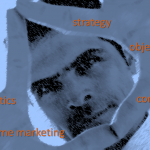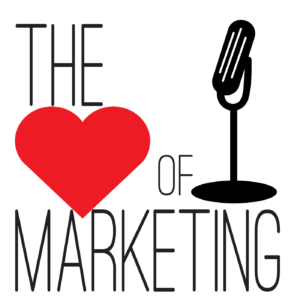In the beginning marketers created content. The content was without form and substance; and chaos was on the face of the internet.
Then Google said, “Let there be algorithms.” And Google called the algorithms ‘SERP’.
This brought order to the chaos and the marketers saw that it was good. Then the marketers optimized the content with abundant keywords until it overflowed. And Google saw that it was not good.
Then Google said, “Let there be quality content.”
And the content marketers said, “What the hell does that mean?!”
That’s the question we tackle in this episode of The Heart of Marketing. We look at where we’ve been and where we are going in the post-Hummingbird world of content marketing. And we answer the question many marketers have today: what is quality content?
It is more than optimizing for discovery. It is about creating ridiculously valuable experiences that will differentiate your brand. Hear some big ideas from industry leaders on how content quality is evolving.
In this episode you’ll learn:
- Vox Media’s secret to publishing quality content
- The limitations of optimizing content for discovery alone
- The shift to ‘Youtility’ content and customer-defined value
- How customer experiences will redefine content quality
- Plus more
024: How to differentiate your brand with quality content
Show notes and resources
Vox CEO says quality will trump ‘clickbait’
Youtility by Jay Baer
Experiences: the 7th Era of Marketing by Robert Rose & Carla Johnson
John: Hi friends, and thanks for joining us today. I am John Gregory Olson, with my co-host, the rock hot Jayme Soulati. How are you?
Jayme: Giggling as usual. Hi John!
John: Right. That's a good sign. That means we're in for some fun.
Jayme: I hope so. I didn't play tennis this morning so I'm much more calm.
John: Okay. Don't have the adrenaline rush?
Jayme: Not the rush, yes. You know the post-tennis rush, it's pretty amazing, keeps me high all day.
John: Well, it's better than other things.
Jayme: True that. Right.
John: We’re getting a little old for that stuff anyways.
Jayme: Totally. We're not going to even go there gosh! We're not going to go there at all, no way, no way. So I wanted to bring up one thing that I saw in the news that I found fascinating and I wonder if anybody listening is kind of thinking about gender marketing. I saw a story in the Wall Street Journal recently that a shop in Venice Beach in California was catering to men and guess what they're doing.
Sound Clip: Ahhhhh!
Jayme: Well, when you think of Venice Beach the profile is men, right? Like body builders, hunks, and all that.
John: Yes.
Jayme: Well they're having...it's a tea shop. They want to...and I think they called it Barracuda Tea or something and they have these hulks sitting out there in front of the store with tea samples trying to...
John: Flexing their muscles?
[Sound clip: Laughter]
Jayme: It kind of sounds like me. I don't like that sound byte. Shoot.
John: Sorry.
Jayme: Yeah right! No, no. New sound byte for my laughter...laugh track. But no, so gender marketing is becoming really huge these days and it feels like everything I read and see, companies are trying to orient to a woman, or a millennial, or a man. I don't know, what do you think about that John?
John: Oh boy. We just had a real long preshow conversation about this one, didn't we?
Jayme: We did.
John: We don't have time to go that deep...
Jayme: No.
John: ...but, well you know, I think it's a smart move for marketers to try to find their niche and to focus on their niche, their broader questions, I’d ...
Jayme: Okay, let me rescue you. So the other one...
John: Thank you.
Jayme: So today, The Wall Street Journal today said that Whole Foods is launching a brand new subsidiary of smaller stores for younger people. So it's fascinating to me that Whole Foods is going to try to go after millennials, or Gen Xers, or folks like that who probably, maybe still live at home and mom and dad buy the groceries. So...
John: So I'm curious, does that mean they wouldn't let me in the door?
Jayme: John, I'm so sorry you have to shop at the real Whole Foods, not the younger, more modern contemporary place.
John: [Laughter] “I'm sorry, you have too many gray hairs ...”
Jayme: [Laughter] Ditto that over here, but I'm not admitting it to anyone. Nada. What are we talking about today John?
John: We're talking about millennials and ...
Jayme: [Laughter] No, get on track. I'm trying to rescue you again.
John: Jayme, you brought to my attention an interesting article in The Wall Street Journal last week about Vox, the online publisher.
Jayme: Okay. Yes I did.
John: Yes! I guess what caught our attention was that they're writing about Vox because they've had some recent success that they were highlighting in the online publishing world. They they have seven websites that cater to different niches. Hey, that kind of ties into what we were talking about earlier ...
Jayme: Yes.
John: ... that they are topics as diverse as sports and food. They've got a publication called "Eater" for food and gaming with a publication called "Polygon." Have you heard of that one?
Jayme: I haven't, actually. I don't really do ... I'm not a big gamer anyway.
John: I'm not at all, but for some reason I have heard of that publication. The one that I have heard of is "The Verge."
Jayme: Okay. Yes.
John: Which focuses on technology stories. So anyways they've got seven of these, and I guess in the last nine months they've seen their website traffic spike 35%.
Jayme: That's so cool.
John: The Wall Street Journal decided to put a spotlight on Vox. They talked to the CEO, who his name I did not write down ...
Jayme: His name is Jim Bankoff.
John: Thank you. And wanted to get his insights on what's the key to their success, and the bottom line is that they talked a lot about content and quality content. That's a buzz phrase that I've been hearing a lot. I'm sure you have too Jayme ...
Jayme: I have.
John: What is quality, right? I've seen a lot of posts that try to tackle that subject and we thought that would be an interesting topic for today.
Jayme: I actually agree.
John: So what is quality content?
Jayme: Gosh, and we could go anywhere with this topic but at the end of the day is there a concise answer that you've found in your research, John?
John: [Laughter] No.
Jayme: I was hoping you would say ...
John: There's a lot of discussion, I think when we get into the next segment we can talk about that a little bit more, but I wanted to highlight a few things that was said in the article first.
Jayme: Okay.
John: They asked the CEO, "What do you consider to be the Vox differentiator?" He said, "Simply creating authoritative brands across categories." So that of course begs the question of what does authoritative mean?
Jayme: Right.
John: But he said, I thought an interesting quote that really ties into where we're going with this today is, he said that, "People aren't going to seek out branded content unless it is compelling, engaging, and data-driven." I guess that is probably how he defines authoritative content.
Jayme: You know what's missing from that though? The fourth thing is, and why do they need it? I mean they have to come to the content for a reason, so I'm not going to sit there. For example, my learnings right now are oriented to SEO and how to drive that funnel for lead generation for my clients. So whenever I see webinars come forth, and blogs come forth, and any other thing I will scan what I see. The unfortunate thing is that, for me, I'm probably an anomaly as a leader in the field. I'm not getting much out of the webinars anymore or the content that I need, I actually need to get one-to-one with some really big guru who can really tell me flat out what to do. For consumers, if you're a consumer company like Vox, and they're targeting consumers and trying to get their visitors to the websites and whatnot, then obviously you've got to have really good, cool content that somebody wants to read.
John: I agree, and that I think is a real nice setup to moving into our next section.
Jayme: Okay.
[Segue bumper music]
John: Okay, we're talking about quality content. What does it mean? I think one of the takeaways from the Vox CEO story that we were talking about in the first segment is that content marketers need to take on an editorial mindset in order to create quality content. I'm sure that you've heard that before, I sure have. It's like, "Oh yeah, you've got to think like a publisher." You know, well, what does that mean? I thought that, in looking at what the discussion of quality content has been, that there seems to be two phases that we've gone through in the conversation. The first phase started with Google algorithm changes and the focus on quality content over gaming, SEO, but that conversation started really, as an SEO-driven conversation.
Jayme: Yes.
John: So a lot of the answers to Google's first question were SEO driven, still. Even though the algorithm changes, Google is trying to wean us off of that ‘tricking the algorithm’ mindset and optimized content for the readers, the user experience, and not for search engines.
Jayme: Well, John let me ...
John: That ...
Jayme: ... let me jump in. Before you get too far down on the path on that, There's some really important things that I need to share on what you just said. The world of SEO writing has always been keyword-esque, and the SEOers who are still in their silos, actually, trying to do robotic copywriting for Google, are suffering now. Because the new SEO is content marketing blended with SEO, on page SEO ...
John: Yes.
Jayme: ... and the ...
[Bell ringing]
Jayme: [Laughter] Right, ding, ding! The newest writing for Google happens to be oriented to consumer behavior. What does a consumer do if they come to your blog post and you've got your keywords in it, and Google is less keyword oriented than ever before. You still need to have the keywords to be noticed by search engines, it's very much a conundrum. But when you develop a blog post, for example, your own content, your own media, you need to have a call to action. You need to have a link, a click, a something that generates an activity, an action by the reader. If that reader clicks on a button, or a link, or a something then Google rewards you with higher ranking. That's how the algorithm has changed. So the SEO writers and the robots, they don't know how to write like that. Because all they've done is pick up graphs of copy, probably taken from other people's work, and tossed it into a blog post with a keyword. That's the old way.
John: Well, they follow a formula, right? You have to have a keyword density of X% and it has to show up in the first 100 words. It has to be here in this headline and this subhead, and it turns into a cookie cutter approach.
Jayme: And John, for my client in the auto collision repair industry, from six months ago, when I got them I've talked about them frequently on this show, I have to say, this does still work. The formula for on-page SEO using your WordPress plugin called Yoast, for example, very much a critical plugin for your WordPress site, Yoast. It's a great app for doing on-page SEO. Actually, it helps you with that keyword density thing.
I have to tell you, even though Google is frowning more on that, on keywords, they still are oriented to that and because of that Yoast plugin and the way I've been writing the blog posts for this auto body shop I've finally got that traction in Google. Their website is finally appearing. It wasn't, it had disappeared. It was a brand new site, took down the old site, and started writing and blogging and doing some local SEO tactics with Moz and using those keywords all over the place. Now finally I have traction, John. The best news ever is that someone came in with a $10,000 repair job and they found the shop on Google.
John: That's a great story, and I agree with you Jayme that we don't want to dismiss fundamental SEO principles in your content. They still need to be there. I think what we're seeing, however, is a movement towards a much more human connection orientated to the content itself. It's one thing to optimize for search and be discovered on the search engines when people are Googling something, and it's another thing to draw them into your content and to convert them into a customer.
Jayme: Sure.
John: I think that the first phase of quality content was how do we optimize in the way that Google wants us to, so that we're still getting that inbound traffic. But I think the next phase, that we are in right now, is how do we create quality content that builds a relationship with our desired customers and loyalty with our current customers? That is not through SEO tricks.
Jayme: No, and actually Bankoff said in his article that this third phase of where we're at today is rich media. Rich media includes video and streaming and these new ways of sharing content with folks that people aren't adopting quickly, but video is difficult. Just like the barriers of entry for a podcast, John, being a video expert and doing shared content via video, that's a huge environment that people have to learn and have the equipment and etc. But ...
John: You do, and here's the thing: It's easy. I mean anybody can shoot a video on their phone, their smartphone. So the technology is relatively easy. The hard part is doing it well.
Jayme: Absolutely, and I do that. I do two-minute Soulati Media on the street. I've done that for years. I have a YouTube channel. It's pretty... [Laughter] There's not much populated on there but interviews with my buddies I meet at conferences. They're two minutes, and I do it with my iPhone and they're hilarious because I just kind of you know, laugh all the way through but it just kind of, you know, puts a few videos up there for me to jump into. I never had...I mean editing in the YouTube video editor, that's a start for you, but everything takes time. You know you've got to... if you want to have quality, authoritative, branded-best content that your users engage with, you've got to have new things to share. You've got to learn, you've got to take the time to connect with your user, your visitor, your consumer, your guest on your blog with new things.
John: Yes. I agree with that. One of the things that I wanted to talk about regarding that, I like to refer to it as the customer-defined value because we have, as businesses, we know what our value is. It doesn't matter what our interest is, we have to shift over and think about what the customer defines as value. One of the best books I've read recently that really digs into this idea is "Youtility" by Jay Baer. Did you read that one?
Jayme: I have it. I get all the books, and then I kind of don't read them so ... [Laughter]
John: Oh, it's an easy read too. It's not one of those dense, academic things. It's a fun read, but it's got great ideas in there. He coined the term "youtility," spelled Y-O-U-tility, the purpose is to point your focus on you, not me. You, the customer, not me the business.
Jayme: Yes, I saw Jay Baer when he first presented, the first conference a couple years ago when his book was just published, just published, and in fact it wasn't even out yet. He gave a presentation, a keynote...
John: Oh, that would have been great.
Jayme: The conference where I spoke ... Oh yes, it was really great.
John: He defines ‘youtility’ as marketing turned upside down.
Jayme: Perfect.
John: Where instead of marketing that's needed by a company, it's marketing that's wanted by the customers.
Jayme: There you go. That's exactly what I said.
John: So what you do is you develop content, and you develop apps and business practices, but they are focused on being useful. They create long-term trust and affinity between you and your customer, but they're useful and they're helpful. They're relevant to where the customer is right now. All of those ideas are expanded at length in the book.
Jayme: You know, I have to say, I have to jump in because what you're saying there...what you just said, I hope people can remember what you just said is very, very important. I read so many websites. I do message mapping, so I'm very familiar and aware of how a company positions itself, but when folks write a blog post or a website, for example, the copy pretty much always sucks.
John: Yes.
Jayme: You know, it doesn't...it's more blabble about, "Hey, we just went to a conference and spoke and we got an award." Who cares? It's like, what does that mean for your audience and please position yourself, Mr. Company, Miss Company, in the mind of your reader. How can you help that person take away a perception, a fondness, a loyalty, an emotion that will help you keep them coming back for more?
John: Right, and I think there's a couple of points that answer that question. That is, when people come to a website or they're searching on their smartphone, they have a series of thoughts in their head that if you are thinking about them, you can be helpful and useful to them. They're looking to solve a problem of some sort. When you're Googling something, you're either looking for an answer to a question or you're looking for a solution to a problem that you have. Those are the two primary functions for Googling something, so if your content is providing that, you're going to be seen as a valuable provider by the people that are searching.
Jayme: And you know the other thing, too, that we should throw in here is bounce rate. If you do have valuable content, you'll know it because you'll know how many people uniquely come to that piece of content and you'll know how long they stay reading that piece of content. If your bounce rate is high, that means people escape quickly from your site. So keep that in mind when you're writing neat content that people resonate with.
John: Yes. The other factor too that is becoming more and more important in how people decide if content is valuable or quality is the entertainment value of it.
Jayme: Yes.
John: Being able to evoke an emotional reaction, either funny, humorous, or the whole range of emotions. People are looking for experiences as much as they are looking for answers. I think this is an interesting idea that I have been exploring, and I just started reading a new book that came out recently by Robert Rose from over at the Content Marketing Institute.
Jayme: Yes.
John: And he's written this book called, "Experiences: The Seventh Era of Marketing." His premise in the book, and I've just started, so I wish I was further along so I could share more, but that's probably okay. But his premise is that, right now the world of marketing is entering into a new era which we need to create experiences; that customers are seeking to be delighted and surprised and informed and entertained. They're seeking out brands that are going to align with their purpose and their values, so we're at a stage in the marketplace where customers value experiences over the products or services. Marketers have to respond with content that not only describes the value of their products or their services, but they also must start to create a differentiated experiential value.
Jayme: Okay John, you're getting into a whole other realm of topic, because I want to share...I want to kind of synopsis what you just said. You're saying that marketing is upside down because all of a sudden, marketers have to determine, how do we connect with our customer and prospect? What are we going to do differently for our company's brand and products and services that resonate more deeply with the human side and the heart..
John: Right.
Jayme: ...of the consumer?
John: Yes. Exactly. That's what it's leading up to.
Jayme: Yes! Well...
John: I just did the set up, you did the slam dunk.
Jayme: Well...[Laughter] I just had to...I'm like, yes, this is crazy, because all of a sudden companies are really needing to do something different, and they're just realizing that now. So we should probably look at brands in the future. We kind of have a feel on our show here, John, about brands that have always stuck their neck out, brands that have always tried to connect with their consumer. Starbucks comes to mind. We've said yay and nay to Starbucks in how they approach their mission statement, but at the end of the day Starbucks does come to mind with how it tries to engage with its consumer with issues that are heartful.
John: Yes. We also talked about Trader Joe's, and I think Trader Joe's really is a good example of this creating an experience beyond their product and their service.
Jayme: I totally have to agree.
John: So Jayme, do you have anything more that you want to add to this? I think we've kind of talked it out.
Jayme: I think we have too, John, I think it's a great show. Just a couple of takeaways for people who were listening, if you just want to recap and surmise in a few points, is just authenticity begins with the heart. If you're going to be cold and just spew facts and data to your readers, nobody is going to listen or read or come back. If you can find what makes you tick from the heart, then your copy and your brand will resonate and become more powerful with your audience.
John: Right on. I couldn't agree more.
Jayme: Ready to wrap up?
John: Take us home, Jayme.
Jayme: Guys, go be rock hot. Thanks so much for listening.
John: Until next time, remember: go for the heart, you won't go wrong.
Recording: Thanks for listening to The Heart of Marketing podcast, with Jayme Soulati and John Gregory Olson. Don't miss our next program. Subscribe to The Heart of Marketing podcast today.












Speak Your Mind